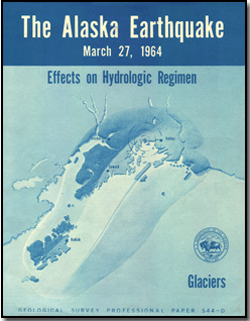Skip Links
Effects of the March 1964 Alaska Earthquake on Glaciers
By Austin Post
 Abstract Abstract
The 1964 Alaska earthquake occurred in a region where there are many hundreds of glaciers, large and small. Aerial photographic investigations indicate that no snow and ice avalanches of large size occurred on glaciers despite the violent shaking. Rockslide avalanches extended onto the glaciers in many localities, seven very large ones occurring in the Copper River region 160 kilometers east of the epicenter. Some of these avalanches traveled several kilometers at low gradients; com-pressed air may have provided a lubricating layer. If long-term changes in glaciers due to tectonic changes in altitude and slope occur, they will probably be very small. No evidence of large-scale dynamic response of any glacier to earthquake shaking or avalanche loading was found in either the Chugach or Kenai Mountains 16 months after the 1964 earthquake, nor was there any evidence of surges (rapid advances) as postulated by the Earthquake-Advance Theory of Tarr and Martin.
|
This report is presented in Portable Document Format (PDF); the latest version of Adobe Reader or similar software is required to view it. Download the latest version of Adobe Reader, free of charge. |
Suggested citation:
Post, A., 1967, Effects of the March 1964 Alaska earthquake on glaciers: U.S. Geological Survey Professional Paper 544–D, 54 p., https://pubs.usgs.gov/pp/0544d/.
Contents
Abstract
Introduction
Hydroseismic Data
Hydroseismograpms from the Nunn-Bush Shoe Co. Well, Wisconsin
Geographic Distribution of Hydrologic Effects
Hydroseisms from Aftershocks
Conclusions
References Cited


